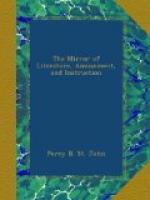Bewick’s first tendency to drawing was noticed by his chalking the floors and grave-stones with all manner of fantastic figures, and by sketching the outline of any known character of the village, dogs, or horses, which were instantly recognised as faithful portraits. The halfpence he got were always laid out in chalk or coarse pencils; with which, when taken to church, he scrawled over the ledges of the bench ludicrous caricatures of the parson, clerk, and the more prominent of the congregation. These boards are now in the possession of the Duke of Northumberland, by whom they were replaced; and when his chalk was exhausted, he resorted to a pin or a nail as a substitute. In consequence of this propensity to drawing, some liberal people, of whom he says, there were many in Newcastle, got him bound apprentice to a Mr. Bielby, an engraver on copper and brass. During this period he walked most Sundays to Ovingham (ten miles,) to see his parents; and, if the Tyne was low, crossed it on stilts; but, if high-flowing, hollaed across to inquire their health, and returned. This infant genius (but it was the infant Hercules struggling with the snakes) was bound down by his master to cut clock-faces and door-knockers—ay, clock-faces and door-knockers!—and he actually showed me several in the streets of Newcastle he had cut. At this time he was employed by Bielby to cut on wood the blocks for Dr. Hutton’s great work on Mensuration. Hutton was then a schoolmaster at Newcastle (1770.)
After his apprenticeship, he worked a short time for a person in Hatton Garden; but he disliked London extremely, still panting for his native home, to whose braes and bonny banks he joyously returned; where he was occupied in cutting figures and ornaments for books; and now received his first prize from the Society of Arts for the “Old Hound,” in an edition of Gay’s Fables. A glance at this cut will show what a low state wood-engraving was at, when a public society deemed it worthy a reward; yet even in this are readily visible some lines and touches of the future great master of this delicious art. He never omitted visiting itinerant caravans of animals, from whose living looks and attitudes he made spirited drawings. This led to his History of Quadrupeds, 1790; the first block, however, of which, he cut the very day of his father’s death, Nov. 15, 1785. From this work he obtained very considerable celebrity; which led him shortly to draw and engrave the wild bull at Chillingham, Lord Tankerville’s, the largest of all his wood-cuts, impressions of which have actually been sold at twenty guineas each; and also the zebra, elephant, lion, and tiger, for Pidcock (Exeter ’Change,) copies whereof are now extremely scarce and valuable. He also executed some curious works on copper, to illustrate a Tour through Lapland, by Matthew Consett, Esq.; and his Quadrupeds having passed through seven editions, his fame was widely and well established.




